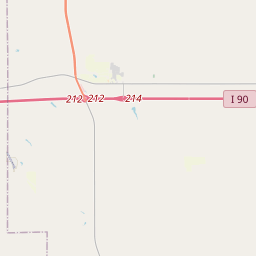How Come They Called it Presho
Historical marker location:
Presho, South Dakota
( Marker can be reached from the intersection of State Highway 248 and Oak Ave.)
Marker installed: 1955







© OpenStreetMap contributors
Loading...
Searching for other points of interest within 5 miles of this location.The town of Mitchell, South Dakota is home to the world's only corn palace, a building decorated entirely with corn and other grains.
About Lyman County
Lyman County Timeline
Lyman County, located in South Dakota, has a rich history that dates back several centuries. The area was originally inhabited by various Native American tribes, including the Lakota Sioux. The first European explorers to visit the region were part of the Lewis and Clark Expedition in the early 19th century. They were followed by fur traders and missionaries, who established some of the first settlements in what is now Lyman County.
The establishment of the Fort Pierre to Deadwood Stage Line in the late 19th century played a significant role in the development of Lyman County. This stagecoach route opened up the region for settlement and brought increased trade and commerce. In 1878, the Chicago, Milwaukee, and St. Paul Railroad reached the area, further facilitating settlement and the growth of towns in the county.
Agriculture became the backbone of Lyman County's economy in the early 20th century. Farmers began cultivating the fertile soil, planting crops such as wheat, corn, and oats. The county's agricultural industry also benefited from the construction of the Oahe Dam on the Missouri River in the 1950s, which provided irrigation and hydroelectric power to the region.
Today, Lyman County is a rural community that continues to rely on agriculture. The county is known for its vast stretches of farmland and ranches. It is also home to several recreational areas, including parks, wildlife refuges, and the Lake Francis Case reservoir, which offer opportunities for outdoor activities such as fishing and hunting. With its rich history and natural beauty, Lyman County remains a picturesque part of South Dakota.
The establishment of the Fort Pierre to Deadwood Stage Line in the late 19th century played a significant role in the development of Lyman County. This stagecoach route opened up the region for settlement and brought increased trade and commerce. In 1878, the Chicago, Milwaukee, and St. Paul Railroad reached the area, further facilitating settlement and the growth of towns in the county.
Agriculture became the backbone of Lyman County's economy in the early 20th century. Farmers began cultivating the fertile soil, planting crops such as wheat, corn, and oats. The county's agricultural industry also benefited from the construction of the Oahe Dam on the Missouri River in the 1950s, which provided irrigation and hydroelectric power to the region.
Today, Lyman County is a rural community that continues to rely on agriculture. The county is known for its vast stretches of farmland and ranches. It is also home to several recreational areas, including parks, wildlife refuges, and the Lake Francis Case reservoir, which offer opportunities for outdoor activities such as fishing and hunting. With its rich history and natural beauty, Lyman County remains a picturesque part of South Dakota.
Lyman County Timeline
This timeline provides a condensed summary of the historical journey of Lyman County, South Dakota.
- 1803 - The area that would become Lyman County is acquired by the United States as part of the Louisiana Purchase.
- 1858 - The Yankton Sioux Reservation is established, covering a large portion of present-day Lyman County.
- 1863 - The Homestead Act is passed, leading to increased settlement in the region.
- 1873 - The first post office opens in what is now Presho, the future county seat of Lyman County.
- 1881 - Railroads reach the area, facilitating further development and economic growth.
- 1883 - Lyman County is established as a county in Dakota Territory.
- 1912 - South Dakota becomes a state, with Lyman County remaining one of its counties.
- 1933 - Construction of the Fort Randall Dam begins on the Missouri River, eventually leading to the creation of Lake Francis Case and influencing the county's economy.
- 1962 - The Oahe Dam on the Missouri River is completed, further impacting the county's landscape and water resources.
- 1978 - The Lower Brule Indian Reservation is established in the southeastern part of the county.